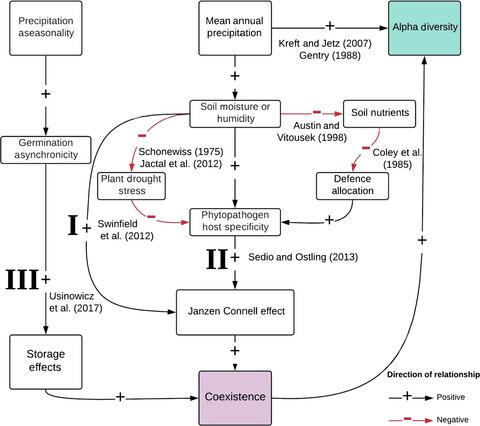Our official English website, www.x-mol.net, welcomes your feedback! (Note: you will need to create a separate account there.)
Responses of plant–pathogen interactions to precipitation: Implications for tropical tree richness in a changing world
Journal of Ecology ( IF 5.5 ) Pub Date : 2020-02-19 , DOI: 10.1111/1365-2745.13373 Valerie R. Milici 1 , Dipanjana Dalui 1 , James G. Mickley 1 , Robert Bagchi 1
中文翻译:

植物与病原体相互作用对降水的响应:变化中世界对热带树木丰富性的影响
更新日期:2020-02-19
Journal of Ecology ( IF 5.5 ) Pub Date : 2020-02-19 , DOI: 10.1111/1365-2745.13373 Valerie R. Milici 1 , Dipanjana Dalui 1 , James G. Mickley 1 , Robert Bagchi 1
Affiliation

|
- Tropical tree‐species richness is positively correlated with annual precipitation, but the mechanisms remain unclear. Phytopathogens promote tree‐species coexistence by disproportionately afflicting seedlings of locally abundant species, generating a rare species advantage. We consider whether increased plant–pathogen interactions in humid conditions favourable for phytopathogens could drive the precipitation‐richness relationship by accentuating the rare species advantage.
- Support for this mechanism requires that increases in disease under humid conditions disproportionately affect locally abundant species without spreading to rarer species. This criterion would be augmented by either increased phytopathogen host‐specificity under humid conditions, or increased asynchronicity in germination of different tree species.
- Research suggests that precipitation increases the rare species advantage. Increased precipitation enhances phytopathogen transmission, making escape from specialist pathogens more difficult. Additionally, drought stress predisposes plants to disease, especially by opportunistic pathogens. As seasonality in wet forests decreases, scope for asynchronous germination among species increases, potentially concentrating disease transmission within species.
- Synthesis. The pathways we identify could drive the precipitation‐richness relationship, but finding direct evidence for them remains a priority. Researching these pathways is especially important because decreasing precipitation due to climate change could disrupt key species coexistence mechanisms and erode tree‐species richness.
中文翻译:

植物与病原体相互作用对降水的响应:变化中世界对热带树木丰富性的影响
- 热带树种的丰富度与年降水量呈正相关,但机制尚不清楚。植物病原体通过过度折磨当地丰富物种的幼苗来促进树种共存,从而产生稀有物种优势。我们考虑在有利于植物病原体的潮湿条件下增加植物与病原体的相互作用是否可以通过强调稀有物种的优势来驱动降水与丰富度的关系。
- 支持这种机制要求在潮湿条件下疾病的增加不成比例地影响当地丰富的物种,而不会扩散到稀有物种。在湿润条件下增加植物病原体宿主特异性,或增加不同树种发芽的异步性,可以提高这一标准。
- 研究表明,降水增加了稀有物种的优势。降水增加会增强植物病原体的传播,使逃脱专业病原体更加困难。另外,干旱胁迫使植物容易患病,尤其是机会病原体。随着湿林季节的减少,物种间异步发芽的范围增加,潜在地集中了物种内部的疾病传播。
- 综合。我们确定的途径可能会推动降水与丰富度之间的关系,但为其寻找直接证据仍然是当务之急。研究这些途径尤为重要,因为气候变化引起的降水减少可能破坏关键物种的共存机制并侵蚀树种的丰富度。



























 京公网安备 11010802027423号
京公网安备 11010802027423号